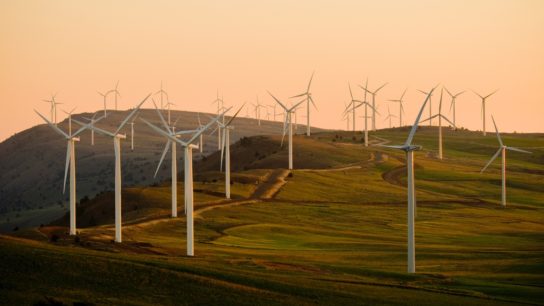Earth.org spoke with Dr. Ed Stafford, Utah State University professor at the Hunstman School of Business, about how savvy marketing strategies can help promote sustainable technologies such as electric stovetops.
—
Do not mess with Texas. The popular slogan among Texans that is thought to be a state motto, was a green marketing public service announcement that started in the mid-1980s to reduce littering. At the time, Texas was spending $20 million in tax revenues annually to pick up trash along highways. The campaign aimed to “show your Texas pride” through the identity of being a proud Texan. The campaign was a huge success and resonated with demographics that would have otherwise cared very little about environmental issues.
This example of savvy marketing became a case study that Ed Stafford, Utah State University professor in the Huntsman Business School, teaches to his students. It is an “identity” strategy that Stafford lectures on in one of his popular marketing strategy classes and one he also implements in his work on green marketing campaigns. In both lecture and implementation, Stafford seeks to understand what makes some brands widely popular and “cool”, while similar brands cannot gain footing with similar audiences. What makes Apple better than Samsung, and Stanley water bottles so popular among millennials and Gen Z’s?
According to Stafford, these products have the “cool” factor. These products and ideas are engineering coolness through marketing actions.
On a mission to learn more about how these marketing ideas could be used for environmental stewardship and promoting sustainable technologies in our fight against climate change, Earth.Org reached out to Stafford and his daughter, Victoria Stafford, who is now working alongside him to promote the benefits of electric stovetops in the US.
When Earth.org spoke to Staffort about the application of these marketing techniques for climate action, he had this to say: “The lesson for climate change is that advocates need to tap key groups and leverage their emotions and identity to encourage climate concern and action. There are some groups with strong identities that can initiate that concern and action. Good marketing strategists can figure these connections out.”
Stafford and his daughter are using these very techniques to promote electromagnetism, more commonly known as induction stove tops. They have keyed in their target market as professional and celebrity chefs, using the slow food, farm-to-table, healthy, organic food movement to promote a sustainable technology in induction stove tops over traditional gas stoves. Not only do induction stove tops help towards electrifying our built environment but they also eliminate a list of health hazards within our living environments.
For decades, traditional gas stove tops have been widely popular in both commercial kitchens and in households across the US. The slogan “Now We’re Cooking with Gas” came around in the late 1930s as a way for the natural gas industry to promote gas stoves. It was promoted as the “best” way to cook, and many chefs swore by it.
However, with the implications of climate change, the push to electrify stoves in a bid to reduce fossil fuel consumption has grown. Gas stoves run off natural gas, a methane emitter. Methane is a major contributor to the total greenhouse gas emissions, second only to carbon dioxide (CO2). It is 84 times more potent in trapping heat in the atmosphere than CO2 over a two-decade period and it possesses a 100-year global warming potential 28-34 times that of CO2.
You might also like: Gas vs Electric Stoves: Which One Is Better for Your Health and the Environment?
Not only are gas stoves harmful emitters for the climate, but they are also linked to a long list of human health concerns. Indoor air quality is drastically diminished with gas stoves in use. Documentation shows that methane leakage from gas stoves, even while off, is considerable. One study found that 12.7% of all childhood asthma cases in the US could be attributed to gas stoves in their home. With health concerns and climate change, many cities have turned to banning gas stoves altogether, creating a hot button topic that was politicized and ignited a cultural war.
“If the maniacs in the White House come for my stove, they can pry it from my cold dead hands,” tweeted Rep. Ronny Jackson (R-Texas). As talk of bans on gas stoves heated up, so did the rhetoric around them. Several members of Congress even got together and proposed the Gas Stove Protection and Freedom Act.
The cultural war was on. No one, however, was discussing solutions to the true health concerns of gas stoves. One of the reasons for this is the lack of awareness surrounding induction stove tops, which in the US has captured less than 5% of the market.
“Our challenge is how to make an environmentally preferable appliance sexy? If the gas industry could make gas stoves a coveted possession 90 years ago and turn its marketing slogan ‘Now we’re cooking with gas’ into an iconic adage that people equate with ‘doing it right,’ our current task is to counter that by making induction a ‘cool,’ coveted feature of the modern kitchen,” said Stafford.
And this is exactly why he and his daughter keyed into professional chefs: to help bring awareness to induction stoves and get more commercial kitchens using the technology.
But what exactly is an inductive stove and electromagnetism?
Inductive stove tops have an oscillating magnetic field that produces a current moving back and forth on an electric wire; this motion is then passed through to the cookware above. Benefits of inductive cooktops include lightning-fast heating and boiling; easy to clean; reduced risks of burns as they are safe to the touch; energy efficient; and capabilities of being paired with clean energy sources, making them environmentally friendly. Not to mention the eliminated pollutants on indoor air quality are better for human health.
These benefits need to be promoted for mass adoption to be possible, and for continued building electrification to happen across the US. Stafford’s work with chefs, especially ones touting healthy, organic, and sustainable cooking, will hopefully help others identify with induction stoves in their homes. They believe celebrity chefs, foodie influencers, and restaurant owners will be key to mass adoption, as they are able to show the benefits of induction stove tops, make them “cool”, and get more people talking and transitioning to them.
Making induction “sexy” and the “only choice for cooking” is going to take significant work. Gas has been king for decades, and marketers did a wonderful job in influencing us to think that. But times have changed, and the rapidly unfolding climate crisis requires us to find new ways of doing things.
We have the solutions to unfix the issues of our past and create a more sustainable world. We also have more government support and funding than ever before to make this transition equitable and obtainable. With funding from the Inflation Reduction Act (IRA) being dispersed for electrical upgrades, the transition to electrical cookware is achievable. But it is with the help of people working on savvy marketing campaigns, like Stafford and his daughter Victoria, that we can make it a reality.
Their new campaign “Get Off Your Gas” is purposely edgy to touch on “rebelliousness” that is inherent in cool products. If we’re going to solve the climate crisis and cultural wars that follow, we may need to think in a whole new way about the way we promote these items and ideas. Savvy marketing and a bit of electromagnetism may be one way forward.
This story is funded by readers like you
Our non-profit newsroom provides climate coverage free of charge and advertising. Your one-off or monthly donations play a crucial role in supporting our operations, expanding our reach, and maintaining our editorial independence.
About EO | Mission Statement | Impact & Reach | Write for us














